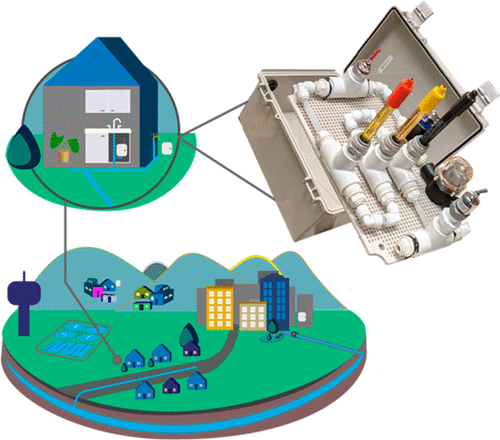当前位置:
X-MOL 学术
›
ACS ES&T Eng.
›
论文详情
Our official English website, www.x-mol.net, welcomes your
feedback! (Note: you will need to create a separate account there.)
Wireless Sensors for Measuring Drinking Water Quality in Building Plumbing: Deployments and Insights from Continuous and Intermittent Water Supply Systems
ACS ES&T Engineering ( IF 7.4 ) Pub Date : 2021-10-24 , DOI: 10.1021/acsestengg.1c00259 Ernesto F. Martinez Paz 1 , Meagan Tobias 1 , Estefania Escobar 1 , Lutgarde Raskin 1 , Elizabeth F. S. Roberts 2 , Krista R. Wigginton 1 , Branko Kerkez 1
ACS ES&T Engineering ( IF 7.4 ) Pub Date : 2021-10-24 , DOI: 10.1021/acsestengg.1c00259 Ernesto F. Martinez Paz 1 , Meagan Tobias 1 , Estefania Escobar 1 , Lutgarde Raskin 1 , Elizabeth F. S. Roberts 2 , Krista R. Wigginton 1 , Branko Kerkez 1
Affiliation

|
Despite continued calls to increase the monitoring of drinking water systems, few communities and utilities have adopted modern, distributed, and real-time monitoring systems. Measurements of drinking water quality are often only made at the treatment plant, with limited grab sampling taking place throughout the distribution system. At the building level, where most of the public’s exposure to drinking water takes place, the capacity to make continuous measurements to characterize water quality dynamics has been almost impossible. Innovation in sensors, microcontrollers, and data services is underpinning a broader smart cities movement, but their value as a tool in the management of drinking water systems is still unclear. In this paper, we present a new open-source wireless sensor platform, which allows water quality to be measured at the tap. Our internet-connected devices transmit data back to cloud hosted services, where they can be analyzed in real-time. We provide examples of large-scale deployments within buildings in Ann Arbor, Michigan, USA and Mexico City, Mexico. In each of these studies, we demonstrate the detection of phenomena that would have been missed through existing, low-throughput monitoring approaches. The deployment in Ann Arbor emphasizes the importance of real-time measurements in a drinking water distribution system, highlighting shifts in neighborhood-scale electroconductivity (a proxy for total dissolved solids) that would have been missed as part of established sampling procedures. The Mexico City deployment demonstrates highly variable water quality and supply in intermittent systems and characterizes the variability of chlorine concentrations between continuous and intermittent portions of the city.
中文翻译:

用于测量建筑管道中饮用水质量的无线传感器:来自连续和间歇供水系统的部署和见解
尽管不断呼吁加强对饮用水系统的监测,但很少有社区和公用事业单位采用现代、分布式和实时监测系统。饮用水质量的测量通常只在处理厂进行,在整个配水系统中进行有限的抓取采样。在大多数公众接触饮用水的建筑层面,进行连续测量以表征水质动态的能力几乎是不可能的。传感器、微控制器和数据服务的创新正在支撑更广泛的智慧城市运动,但它们作为饮用水系统管理工具的价值仍不清楚。在本文中,我们提出了一个新的开源无线传感器平台,该平台允许在水龙头处测量水质。我们的互联网连接设备将数据传输回云托管服务,在那里可以对其进行实时分析。我们提供了在美国密歇根州安娜堡和墨西哥墨西哥城的建筑物内进行大规模部署的示例。在每一项研究中,我们都展示了对现有低通量监测方法可能会遗漏的现象的检测。安阿伯的部署强调了饮用水分配系统中实时测量的重要性,突出了在已建立的采样程序中可能会错过的邻域级电导率(总溶解固体的代表)的变化。
更新日期:2021-10-24
中文翻译:

用于测量建筑管道中饮用水质量的无线传感器:来自连续和间歇供水系统的部署和见解
尽管不断呼吁加强对饮用水系统的监测,但很少有社区和公用事业单位采用现代、分布式和实时监测系统。饮用水质量的测量通常只在处理厂进行,在整个配水系统中进行有限的抓取采样。在大多数公众接触饮用水的建筑层面,进行连续测量以表征水质动态的能力几乎是不可能的。传感器、微控制器和数据服务的创新正在支撑更广泛的智慧城市运动,但它们作为饮用水系统管理工具的价值仍不清楚。在本文中,我们提出了一个新的开源无线传感器平台,该平台允许在水龙头处测量水质。我们的互联网连接设备将数据传输回云托管服务,在那里可以对其进行实时分析。我们提供了在美国密歇根州安娜堡和墨西哥墨西哥城的建筑物内进行大规模部署的示例。在每一项研究中,我们都展示了对现有低通量监测方法可能会遗漏的现象的检测。安阿伯的部署强调了饮用水分配系统中实时测量的重要性,突出了在已建立的采样程序中可能会错过的邻域级电导率(总溶解固体的代表)的变化。











































 京公网安备 11010802027423号
京公网安备 11010802027423号